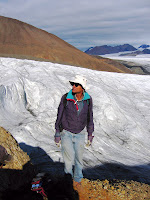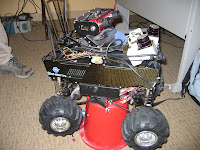Wednesday 30 July 2008
Today we made the 7 km hike to the lower camp with the Max 5R rover batteries and ancillary equipment. The rover is already at the lower camp. We spent most of the afternoon testing setting up the rover operations and testing the rover in the local environments. Everyone was able to easily use the rover due to the well designed and intuitive control system. The rover operated well over the rocky terrain. The main environmental challenge was the dust.
Thursday 31 July 2008
We hiked up again to the relic springs site, this time taking the valley route. No difficulties were encountered on this route. The teachers from the lower camp joined us by helicopter. We conducted extensive sampling at the site and surveying from the hill top to the edge of the White Glacier.
In the afternoon we dug another pit to the level of ice cemented groud (72 cm again) in and area of well developed patterned ground.
In the evening we decided to do a midnight hike to and on the terminus of the White Glacier and along the front of the Thompson Glacier. The midnight sun provided more than enough light despite the heavy clouds.
We concluded our hike at 2 AM and waited for the 3:30 AM total solar eclipse. Unfortunately the solid cloud cover did not let up and slight rain fell.
 Friday 1 August 2008
Friday 1 August 2008Today was our first day with rain. We worked on documenting and packing our samples.
Saturday, 2 August 20085 AM we departed for the hike to the lower camp to catch the twin otter flight to Resolute and from there on to Ottawa.



 Today we made the 7 km hike to the lower camp with the Max 5R rover batteries and ancillary equipment. The rover is already at the lower camp. We spent most of the afternoon testing setting up the rover operations and testing the rover in the local environments. Everyone was able to easily use the rover due to the well designed and intuitive control system. The rover operated well over the rocky terrain. The main environmental challenge was the dust.
Today we made the 7 km hike to the lower camp with the Max 5R rover batteries and ancillary equipment. The rover is already at the lower camp. We spent most of the afternoon testing setting up the rover operations and testing the rover in the local environments. Everyone was able to easily use the rover due to the well designed and intuitive control system. The rover operated well over the rocky terrain. The main environmental challenge was the dust. We hiked up again to the relic springs site, this time taking the valley route. No difficulties were encountered on this route. The teachers from the lower camp joined us by helicopter. We conducted extensive sampling at the site and surveying from the hill top to the edge of the White Glacier.
We hiked up again to the relic springs site, this time taking the valley route. No difficulties were encountered on this route. The teachers from the lower camp joined us by helicopter. We conducted extensive sampling at the site and surveying from the hill top to the edge of the White Glacier.

 Sean, a high school teacher from Sacred Heart School in Stittsville, Canada, calibrates a seismometer yesterday, as the CSA crew collects initial seismic data in a quest to learn what geology underlies Gypsum Springs' outlets. We hope this will help us understand why different spring outlets have widely differing water temperatures even though there are only a few feet away from each other.
Sean, a high school teacher from Sacred Heart School in Stittsville, Canada, calibrates a seismometer yesterday, as the CSA crew collects initial seismic data in a quest to learn what geology underlies Gypsum Springs' outlets. We hope this will help us understand why different spring outlets have widely differing water temperatures even though there are only a few feet away from each other.





 We ate lunch and had our first planning meeting with Wayne Pollard of McGill University. After lunch we hiked down to the active springs at the base of Gypsum Hill. We took a water sample from one of the most studied of the spring sites here:
We ate lunch and had our first planning meeting with Wayne Pollard of McGill University. After lunch we hiked down to the active springs at the base of Gypsum Hill. We took a water sample from one of the most studied of the spring sites here:


 Yes, it's true. At Iqaluit Airport, waiting for our connecting flight to Resolute Bay, the Spaceward Bound Arctic group met Matt Bamsey, a post-doc from the Canadian Space Agency. Matt's work involves researching how to develop autonomous greenhouses for use on the Moon and Mars. The reasoning is that on those missions we don't want astronauts spending a large percentage of their time growing food necessary for their survival during long-duration expeditions. So, if greenhouses can be developed that run automatically, and can handle the unique light and dark environs of both the Moon and Mars, astronauts have more time to devote to the science goals of the mission. Search terms such as "Arthur Clarke Mars Greenhouse Haughton Mars Project Devon Island" for more information.
Yes, it's true. At Iqaluit Airport, waiting for our connecting flight to Resolute Bay, the Spaceward Bound Arctic group met Matt Bamsey, a post-doc from the Canadian Space Agency. Matt's work involves researching how to develop autonomous greenhouses for use on the Moon and Mars. The reasoning is that on those missions we don't want astronauts spending a large percentage of their time growing food necessary for their survival during long-duration expeditions. So, if greenhouses can be developed that run automatically, and can handle the unique light and dark environs of both the Moon and Mars, astronauts have more time to devote to the science goals of the mission. Search terms such as "Arthur Clarke Mars Greenhouse Haughton Mars Project Devon Island" for more information.

 Geoff Hammond and Robert Palassou were at
Geoff Hammond and Robert Palassou were at